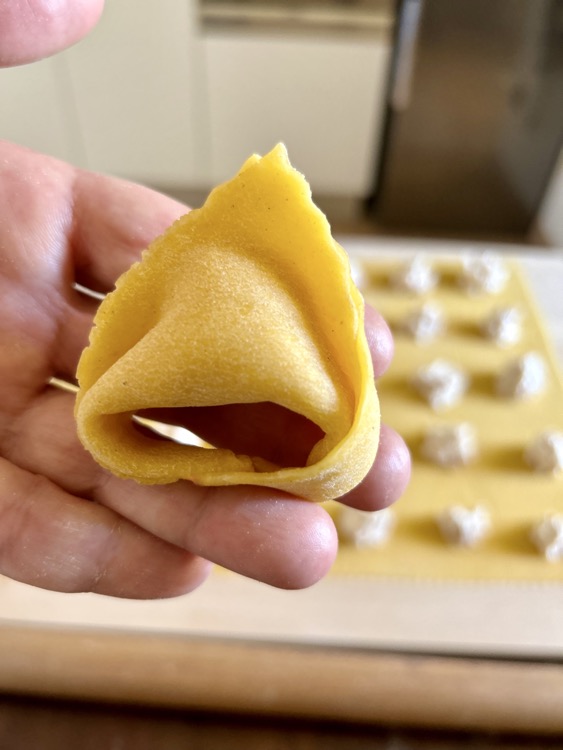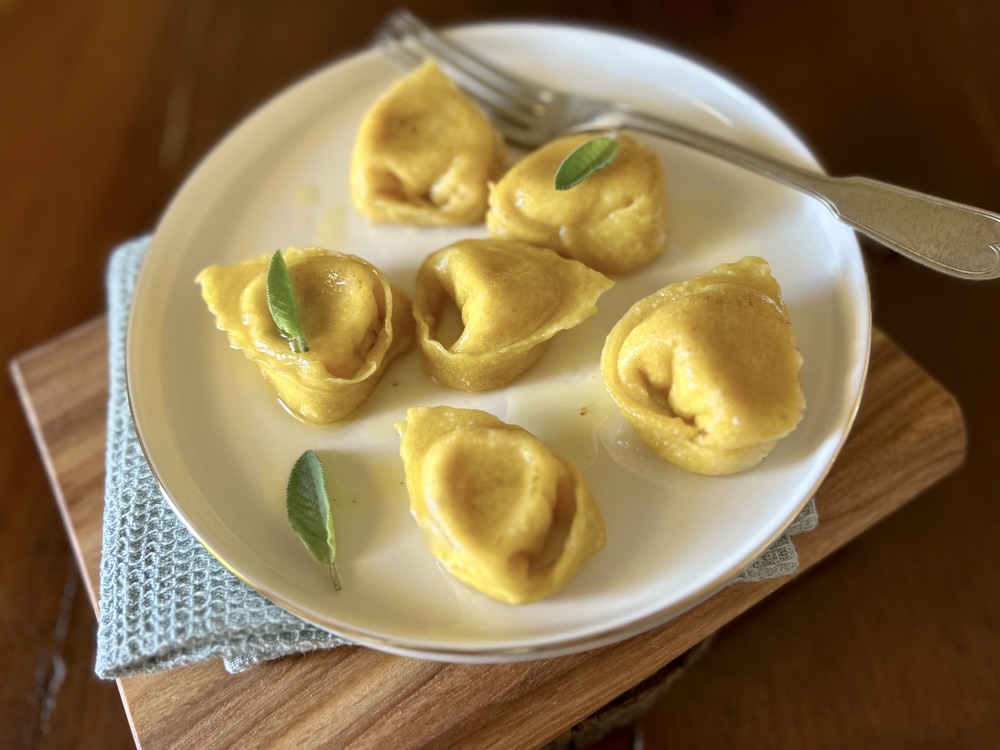About stuffed cappelletti and failures in the kitchen.
I am a home cook, and my teachers have been the grandmothers, aunts and azdore who frequented my home kitchen.
Often the teaching was unintentional. In most cases, I learned through what I saw and the molecules of scented particles I breathed in.

The kitchen and I
I cooked, for a long time, only simple pasta dishes for flatmates and classmates or friends passing through Bologna.
With Saturday night dinners, little by little, I became familiar with roasts and desserts.
Probably my culinary commitment would have remained occasional if I had not received a proposal from a small publisher to write a collection of recipes choosing between flavors from abroad and those of my tradition.
For the first time, while I was writing the book, I cooked systematically for months, trying, almost always several times, the recipes from home where Grandma had pinned down the ingredients without indicating quantities and process.
From occasional cook to regular cook
After this experience, a few more years were to pass before the turning point, but something new took shape in my head.
In 2018, I decided to apply to a cooking school in Florence, where I graduated by taking a course in Basic Cooking. Since that moment, I have not stopped. For a couple of years, I cooked breakfasts and lunches by request for guests at my room&breakfast. I have been the cook for private family events. I have done show cooking and taught classes in my home kitchen. And I have been a Cooking Teacher for Casa Artusi.
And although I do not consider myself a professional but always just a home cook, I now have many years of experience behind me. Well, this practice does not preserve me -still today- from failures in the kitchen.

My kitchen failures
Over time I have tackled insidious preparations. Mayonnaise was a nightmare. Oriella, an exceptional cook, forced me to make it many times, always with a hand whisk before the sauce stopped going crazy.
Recently, an attempt at salt smoking seriously risked turning into a fire that could have had consequences for me and the kitchen.
Distraction is often a cause of failure. For example, I tend to put a pan on the stove and forget about it. I also happened to burn a pan during a cooking class, to say. In addition to distraction, enthusiasm sometimes plays tricks.
The wrong stuffing
Take these stuffed cappelletti. In preparing the filling, I made two mistakes.
First, I blended the pears instead of leaving them in chunks. Then I combined them while still warm with the cheeses.
You should have seen my face as I mixed that batter.
I knew immediately that the mistake was irremediable. Then worse happens.
The old tool I use as a stand for my cell phone while making videos breaks. And my most precious working tool falls into the bowl of batter.
After cleaning up the phone and kitchen, I added an egg to the batter and made it into a savory pie filling.
The day after, I bought the ingredients to remake the filling. The second time it finally had the right consistency. At last, I rolled out the pasta sheet and made the stuffed tortelli.


There is no prescription against failure
I cannot give you a recipe against failures but only some tips to help you prevent them. Clean the countertops and kitchen before cooking. Arrange all ingredients on the table, even salt, water, and spices. Don’t rely on a photo or video. Always read the recipe carefully to be sure there are no missing steps that perhaps the creator omitted for various reasons.
Will it preserve you from fatal distractions that will become failures? No.
But I hope the tale of my mistake will make you feel less alone and in good company.
Also, remember that even a delicacy like Tarte Tatin was born by mistake.
If you can, correct it. And if you can’t, take the advice of food writer Giulia Scarpaleggia and have a plan B ready from the ingredients we (almost always) have in our pantry.
Tomato sauce, canned legumes, dried herbs, spices, and eggs can help you prepare, even at the last minute, one or more tasty dishes.
If, on the other hand, you are not a home cook but a blogger, help your readers not to make mistakes. When writing a recipe, be as accurate as possible. I have made many mistakes in this area, too! I leave you with two links by food writer Dianne Jacob on mistakes to avoid when writing a recipe for others. I reread them often.
Buona cucina, Monica
A few ideas for a Plan B
Eggs, tomato sauce, legumes, and aromatics are never lacking in my pantry.
Eggs and tomatoes are perfect for cooking two quick recipes I love. One is a main course that doubles as a one-pot meal (you can find it here); the second is a sauce for topping the pasta where you mix sauce and raw eggs before baking pasta.
The combination of tomato and parsley also makes a great pasta sauce.
With legumes, you can cook burgers that taste as much as traditional ones and are perfect for getting you out of a jam if you run into trouble.
What if dessert is what you need to remedy? No worries: milk, eggs, sugar, and one fruit will save your end of dinner with a dessert that is easy to make and everyone love.
Reading Tips
Giulia Scarpaleggia, My biggest failures in the kitchen
Dianne Jacob, 7 Most Common Recipe Writing Errors
Dianne Jacob, 7 More Most Common Recipe Writing Errors

Cooking note
Salame rosa (pink salami) is as old as mortadella and perhaps even older.
It is a traditional Bolognese cured meat with a milder flavor than mortadella or the salami recalled in its name. If you can’t find it, substitute it with prosciutto cotto.
Stuffed cappelletti with salame rosa, cheese, and sage pears
serves 4
List of the Ingredients
Pasta dough
00 flour, 400 g
normal eggs, 4
Stuffing
chopped salame rosa, 100 g
fresh mascarpone, 50 g
cow ricotta, 100 g
pear pulp, about 100 g
a few sage leaves
olive oil and salt to taste
Sauce
butter, 200 g
1/2 grated lemon zest
sage, 8 leaves
Method
Sauce
Melt butter, add grated lemon zest, stir, pour into a single-portion mold, let cool, cover with foil, and store in refrigerator overnight or a few hours.
Stuffing
Place the mascarpone out of the refrigerator for an hour and, in the meantime, drain the ricotta.
Peel the pear, remove the core, cut into small cubes, and toss in a pan with a couple of sage leaves, a drizzle of oil, and a pinch of salt. Cook over high heat, stirring, for 2 minutes, then turn it off and let it cool.
Mince the pink salami in a blender or with a knife and keep it aside.
In a bowl or mixer, mix ricotta and mascarpone. Then add finely chopped pink salami, mix again, also add pears, and mix the filling.
Cover the bowl and place in the refrigerator for one hour.
Pasta dough
Arrange the flour on the cutting board. Then create a hole in the center, and place the eggs. Break the eggs with a fork, slowly incorporate the flour from the sides and mix with the eggs.
When the dough is too compact for the fork, continue kneading with your hands until the dough is smooth, not too hard or soft.
Wrap the dough with plastic film. Let it rest out of the refrigerator for about 30 minutes.
Roll out a thin sheet with a rolling pin or a pasta machine.
Stuffed tortelli
Cut the pasta sheet into squares about 3-4 cm per side.
In the middle, arrange 1/2 tablespoon of filling.
You will get about 40 tortelli.
Join two tips together to make a triangle. Press your fingers around the filling to let the air escape; press the edges together to seal them. Then join the two tips of the triangle to make tortelli.
Arrange the tortelli on a floured tray.
Cook the filled tortelli in boiling salted water.
In a pan, melt the lemon butter and add the sage.
Using a slotted spoon, move the tortelli to the pan. Add one small ladle of the pasta cooking water, stir gently, and serve.
If you have leftover stuffed tortelli after cooking, store it in the refrigerator for up to two days.





